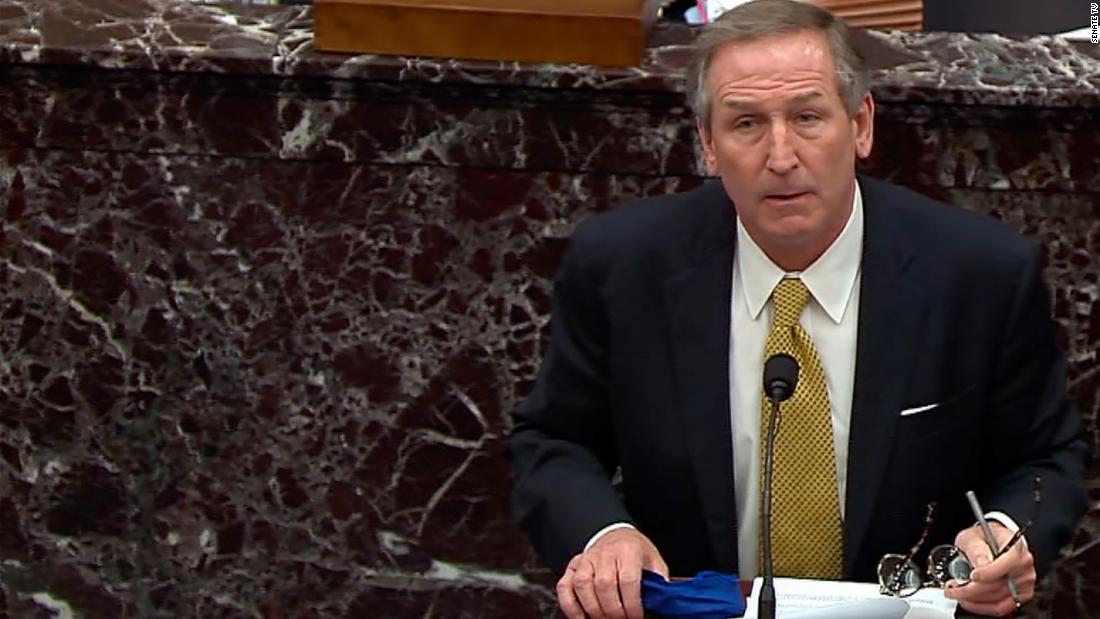
Arguing that Trump did nothing to fuel the uprising in the Capitol on Jan. 6, lawyers twisted the facts about both what happened that day and what happened in the past.
Trump attorney Michael van der Veen highlighted comments from Democrats who he believed had promoted or defended violence. Trump, he argued, is different from these Democrats.
“Compare the president’s repeated condemnations of violence with the rhetoric of his opponents,” said Van der Veen. He then played a video that featured clips of Trump condemning violence and calling himself an “ally of all peaceful protesters,” alongside some selectively edited clips of Democrats.
Facts first: This argument and this video were misleading by omission. Trump has indeed condemned violence and called for peaceful protest, but he has also repeatedly acclaimed or defended violence and aggressive behavior.
Trump’s attorney falsely claims Trump’s first two tweets during the Capitol attack provoked calm
Van der Veen claimed that “the first two messages the president sent via Twitter when the Capitol raid began” urged people to “remain peaceful” and called for “no violence.”
Facts first: This is not true.
Trump’s “keep calm” tweet at 2:38 pm and “no violence” tweet at 3:13 pm were his second and third tweeted posts after the Capitol was breached, not his first. Trump’s first tweet was at 2:24 PM: “Mike Pence didn’t have the courage to do what should have been done to protect our country and our constitution, by giving states the opportunity to certify a corrected set of facts,” not the fraudulent or inaccurate ones they were previously asked to certify. The US demands the truth! ”
Rioters had already entered the US Capitol building by the time of the Trump tweet about Pence.
No, the media did not lie that the 2016 election was hacked
Van der Veen claimed that Washington officials other than Trump are the ones who used reckless and inflammatory rhetoric. He claimed, “The entire Democratic Party and the national news media have repeated for the past four years without any evidence that the 2016 election had been hacked.”
If Van der Veen were to suggest that the “entire Democratic Party and the national media” falsely claimed for four years that hackers altered actual votes or vote totals in the 2016 election, that would not be true either. We cannot speak for every word uttered by every Democrat or every journalist since 2016, but it is clearly incorrect to say that the entire party or the entire media has been working on such a claim for four years. The national discussion of hacking in the 2016 election focused on the actual, confirmed hacking targeting the Democrats’ computer systems.
Castor falsely claims that rioters did not attend Trump’s speech in DC
Trump’s attorney Bruce Castor claimed that the rioters who stormed the Capitol did not attend the ex-president’s inflammatory speech that day, proving that the uprising was a pre-planned attack unprovoked by Trump.
“Given the timeline of events, the Capitol criminals weren’t there at the Ellipse to hear the president’s words,” Castor said. “They were more than a mile away, engaged in their planned attack on this same building.”
“This was a pre-planned attack,” said Castor, “make no mistake.” He also claimed that this claim “was confirmed by the FBI, the Justice Department, and even the house managers.”
Facts first: It is not true that none of the accused Capitol rioters attended Trump’s speech beforehand. And Castor is exaggerating the known facts about whether the attack was pre-planned.
Ellipse to the Capitol
True, the timeline shows that someone who attended the entire speech at the Ellipse was not one of the very first people to break the Capitol grounds. But that’s a much more limited statement than Trump’s attorneys.
Pre-planned?
The Justice Department and the FBI have accused some rioters of planning the attacks before coming to Washington, and top prosecutors have said more charges in that direction are expected. But only a handful of the more than 200 criminal cases indicate that rioters had surfaced that day with the intent of breaking the Capitol.
Therefore, Castor chose a few unrepresentative cases from the pool of more than 215 cases to support his misleading claim that federal investigators “confirmed” that this was a “pre-planned attack.”
No, Georgia did not see a ‘dramatic drop’ in ballot rejections
Castor argued that Trump’s use of the word “find” was “solely related to his concern about Georgia’s inexplicably dramatic drop in rejection rates.”
Facts first: Aside from the intent of Trump’s use of the word “find,” Georgia did not experience a “dramatic drop” in ballot rejections, according to data from the Georgia secretary’s office.
Marshall Cohen contributed to this report.